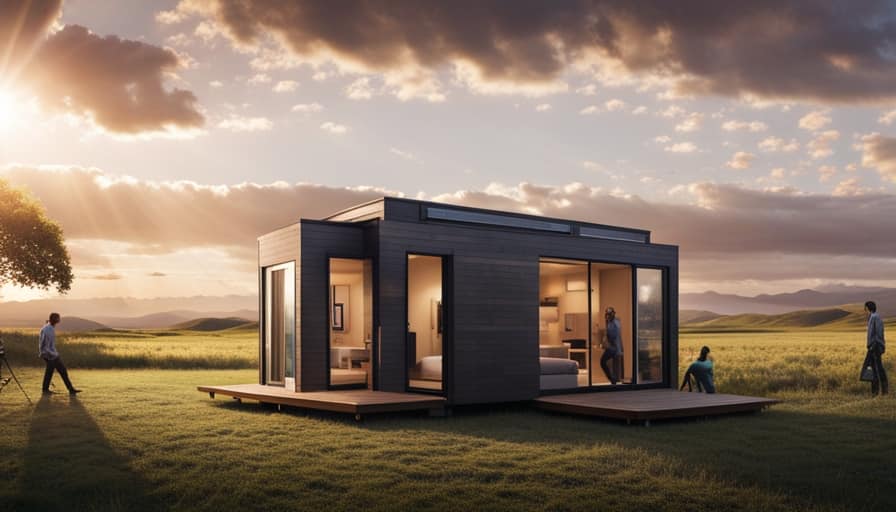If you’re interested in building a treehouse without causing damage to the tree by drilling holes, then this article is perfect for you. It provides different techniques for safely securing a treehouse without the use of drilling or hammering into the tree. These methods are ideal for kids, and you’ll be amazed at how easy it can be to create a treehouse. Keep reading to discover how to use Treehouse Attachment Bolts (TABs) instead of nails and avoid floating joints.
Build a Treehouse without Drilling Into a Tree
If you want to build a treehouse but do not want to risk damaging the tree, there are several ways to attach your construction without drilling into it. The first method involves securing the treehouse using bolts instead of screws. Bolts are designed to support 8,000 to 10,000 pounds of force without damaging the tree. Another way is to use the branches of other trees as anchors for your treehouse.
Before you begin drilling into the tree, you should consult with your local arborist or tree expert to determine the best type of tree for your project. Ideally, you should look for a tree that is either a hardwood or a conifer. Also, you should consider the growth potential of your treehouse as it grows and matures. This method is the least damaging and can be done without causing any major damage.
Once you have selected a suitable tree, you should start construction. The main support for the treehouse should be a 2×10 or a 2×12 wood board that is flush against the trunk. To attach the beams, use 5/8″ galvanized lag screws and washers. The screws should be placed so that they do not strangle the tree. After securing the beams, make sure that the new strip is flush against the other side of the tree.
When it comes to building a treehouse, a well-designed and built structure will prevent any damage to the trees. You should avoid using nails or bolts that can penetrate the tree’s tissue, as these can harm it. Make sure that you use galvanized nails, and choose a high load-bearing tree. Following these guidelines, you can build a treehouse without damaging the tree.
There are several ways to build a treehouse without drilling into a limb or branch. The first option is to use nails and screws to attach the platform to the tree. This is the simplest and most efficient method. But if you don’t want to damage the tree, you can use hammering or nails instead. You can also use the right tree-friendly nails and screws.
Avoid Nailing or Hammering a Nail Into a Tree
You should not drill a nail into your treehouse for several reasons. First of all, it will hurt the tree. The nails will penetrate the tree’s tissues, which carry water and nutrients. The damaged area will have increased stress on the tree and become vulnerable to pests and disease. If the tree is still young and healthy, it will bounce back after being wounded. In addition, drilling into a healthy tree will prevent the tree from growing around the nail.
A common mistake when building a treehouse is drilling a nail into the tree. Although this will cause the tree to suffer damage, you can avoid this by drilling a smaller nail or screw. The size of the nail doesn’t matter as much as the health of the tree. A healthy tree will start compartmentalizing after it is drilled. A stronger tree can handle the stress of the nails. Therefore, you should avoid drilling a nail into a weak tree.
When drilling a nail into a treehouse, you should choose high-quality stainless-steel nails or screws. These types of nails and screws will reduce the risk of rusting and corrosion. In addition, stainless steel will be better for the tree. Moreover, fewer holes means less stress on the tree. If you must drill a nail into the treehouse, make sure to drill it at a point where it is not visible.
A 15-inch galvanized lag bolt can be used to secure the treehouse to the tree. It will allow the building to be attached to the tree with minimal damage to the tree. Another option is to use a bolt and thread it through the tree. Although this method is less effective, it can be the safest way to attach a treehouse to a tree. You can also use an anchor if you are not able to nail the treehouse securely.
In case you do not have a chainsaw, it would be a good idea to use some straps. These straps will secure the treehouse to the tree, but be sure to use one that is at least an inch thick. Any thinner strapping could cause damage to the tree. You should also make sure to loosen the straps as the tree grows. This will keep the treehouse from slipping down the tree.
Use TABs instead of nails to attach a treehouse to a tree
One way to avoid using nails and other tacks for attaching a treehouse to a large tree is to use TABs. These are specialized screw mountings made especially for treehouses. They can also be used for connecting a bridge to a larger treehouse. However, before installing TABs, it is important to know what type of TAB you need to use for a particular tree.
You should also consider the height of the treehouse floor. You should build your treehouse on a branch that is approximately ten feet above the ground. Also, you should select a tree with “V”-shaped branches. This will provide extra support and four anchor points. Before attaching the platform, drill holes in each prong at three-eighths of an inch, and then level the holes. Subtract the distance from each hole from the ten-foot mark to determine the depth of the platform. If the floor is less than ten feet high, use temporary post supports, metal joist hangers, or concrete pier footings.
Nails are dangerous for the trees, because they can penetrate the plant’s tissues and impede its ability to compartmentalize itself. Also, nails can damage the tree’s growth, which can result in stress and health problems. If you plan to use nails, be sure to drill pilot holes first. You’ll need a power drill and a drill bit that is half the diameter of the mounting screw and half the length of the threads on the screw hook.
TABs are specially-designed treehouse attachment bolts. These bolts are made for attaching a treehouse to a tree and distribute the load. Most professional builders use TABs, which are four sections wide and are suitable for loads up to 2000 pounds. When using TABs, make sure to check the tree’s weight capacity, and choose the right fastener to avoid damaging the tree.
A TAB or a floating bracket is a better choice when it comes to fixing a treehouse to a tree. This technique allows you to attach your treehouse without damaging it. However, this technique is not recommended for smaller trees. It is important to note that the diameter of the treehouse trunk should be at least twelve inches. A failed compartmentalization process may damage the tree and result in it being susceptible to disease.
Avoid floating joints
There are a few different ways to build a treehouse without drilling into the tree. One of the most common options is to use flexible joints. These are usually made of steel cables and fixed to the support or to a higher branch. Although this option is cheap, it is important to take care not to damage the tree. Floating joints are more flexible and will allow for more movement.
It is best to avoid using heavy woods, which can result in a weakened tree. The trees will be absorbing most of the weight of the house, so using light materials will ensure a stronger treehouse. Make sure to monitor its stability regularly. Strong windstorms and lightning storms can cause damage to the tree house. Depending on where you live, you may also need to get government approval before you begin building.
To prevent floating joints when building a treehouse without drill-ins, build a mock-up model of the structure in cardboard before starting construction. This way, you can determine any potential issues and adjust your design accordingly. Make sure to make sure that the structure allows enough room for the tree to grow, and then make adjustments accordingly. Once you’ve made all of the necessary changes, the builder can move on to the actual construction.
The best way to avoid wicking water is to ensure that the framing is treated. Use treated lumber and ensure that the cladding and flooring will protect from water and prevent rot. Also, make sure the frame is constructed to allow for growth. By making adjustments accordingly, the frame will support a lot of weight without buckling under the weight. You should also consider the safety of your children when building a treehouse.
Another option to build a treehouse without drilling into tree is to use a sliding joint framework. These frames are more complex to build, but they create low stress and allow for smaller-sized wood. The sliding joint framework is made of a metal ‘J’ bracket which is bolted to the tree and slides over it. You can then screw beams into the flat plate of the floating bracket. This design provides a great deal of flexibility, and allows the tree to expand and contract.
Hi, I’m Emma. I’m the Editor in Chief of Tiny House 43, a blog all about tiny houses. While tree houses are often associated with childhood, they can be the perfect adult retreat. They offer a cozy space to relax and unwind, surrounded by nature. And since they’re typically built on stilts or raised platforms, they offer stunning views that traditional homes simply can’t match. If you’re looking for a unique and romantic getaway, a tree house tiny house might just be the perfect option.










